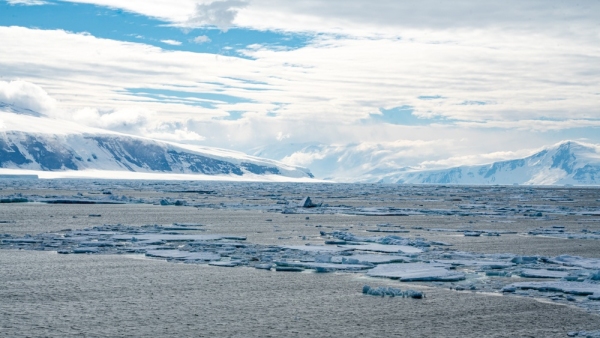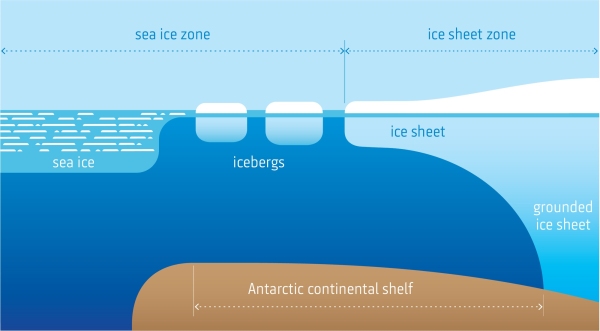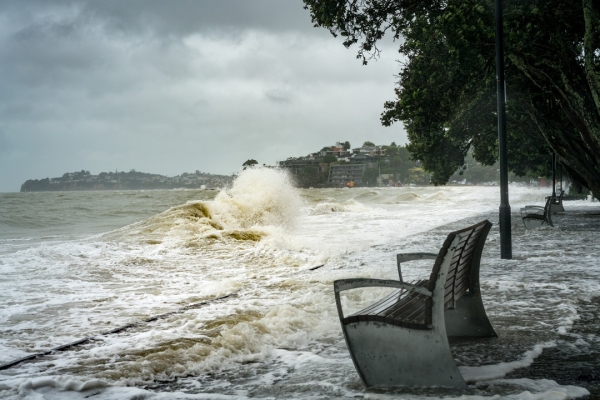On this page:
- The coldest continent on Earth
- What is the difference between ice sheets, ice shelves and sea ice?
- How does Antarctica’s climate affect the rest of the world?
- How does a warming global climate affect Antarctica?
- Antarctica and sea-level rise
- Science on the ice
The coldest continent on Earth
Antarctica is the coldest continent on Earth, but much of it is warming at one of the fastest rates – second only to parts of the Arctic.
At nearly twice the size of Australia, Antarctica is the fifth-largest continent on Earth. It surrounds the South Pole and is surrounded by the Southern Ocean.
Almost all of Antarctica is covered in a thick layer of ice, averaging around 2 kilometres deep. The thickest ice in Antarctica is thought to be nearly 5,000 metres deep.
This icy continent plays a big part in our global climate and, in turn, is directly affected by changes to the global climate – making Antarctica and the climate inextricably linked.
The videos below demonstrate the type of clothing worn to stay warm in Antarctica and pitching a Scott Polar Tent.
What is the difference between ice sheets, ice shelves and sea ice?
Ice sheets are defined as masses of glacial ice made from snow and ice that has fallen on land covering more than 50,000 square kilometres. These flow slowly out towards the sea as gravity acts on the enormous weight of the ice.
Ice shelves are the floating extensions of the land-based ice sheets. They form around the edges of Antarctica, making up almost half of the coastline.
Sea ice is formed from frozen sea water and is free floating. It usually expands during winter and melts during summer, but in some places, it can remain throughout the year. At its winter maximum extent, sea ice effectively doubles the size of the continent when viewed from space.
Over the last 30 years, sea ice has expanded in Antarctica – this is surprising when we consider that the global climate has warmed in this time. NIWA researchers are working to understand why. They think that warmer sea water underneath the ice shelves close to the South Pole may be melting the underside of the ice, causing cold water to flow away from the pole and freeze again on the edges of the continent.
How does Antarctica’s climate affect the rest of the world?
The climate of Antarctica is closely connected to the climate of the rest of the world through the ocean and the atmosphere.
For example, ice melting in Antarctica is causing sea-level rise in other parts of the world and warming seas are impacting the animals living in the ocean.
Sea ice is one of the main features of Antarctica that impacts the climate of the rest of the world. It does this in several ways:
1. Reflecting heat by the ice-albedo effect
The bright white surface of sea ice reflects the sun’s light back out into space. This means less heat is absorbed into the ocean, helping to keep the planet cool. The reflectiveness of the ice is known as its albedo.
During winter when there is more sea ice, the ice-albedo effect causes heat to be reflected out to space. During the summer months there is less sea ice and more dark, open sea water. As dark surfaces absorb heat more easily, more heat is absorbed by the ocean causing the water to warm.
Heat absorbed into the ocean makes it harder for ice to form and increases the chance of the ice next to the water melting. As the planet continues to get warmer the ice albedo effect is increased, and sea ice is melting at a quicker rate. It is expected that the continued melting of sea ice will cause sea-level rise in other areas of the planet.
In the following video, NIWA Antarctic researcher Natalie Robinson explains more about ice-albedo feedback.
2. Supporting ecosystems
Sea ice is important to support ecosystems. When sea ice forms it creates a solid structure that algae can grow on. Algae form an important part of the food web and, with declining sea ice, the production of algae could decrease and have knock-on effects for the rest of the food web. For example, krill, little crustaceans that support most of the ocean food web, feed on this algae. Krill populations have been declining as the sea ice has decreased.
Sea ice also provides a protective habitat for fish and other animals in the ocean. During winter, sea ice covers a large proportion of the ocean. This works like a blanket that protects the upper ocean from the very cold atmospheric temperatures and in turn protects the animals living in the water.
3. Influencing storm formation
Another way sea ice in Antarctica affects our climate is by influencing where storms form around the icy continent. This is because the sea ice forms a barrier between warmer water below and cooler air above, meaning that the air over sea ice tends to be cooler and drier than air over water. This in turn impacts the weather around the world, especially countries in the southern hemisphere. Here in Aotearoa our most ferocious storms tend to come up from down south.
4. Changing ocean currents
Sea ice is made of mostly fresh water. This is because there’s no space for the salt to be incorporated into (or ‘included in’) ice’s crystal structure. When sea ice is forming, the salt is squeezed out of the water and left behind in the surrounding water, making it extra salty
This extra salty, cold water is denser (heavier) than normal seawater so sinks to the bottom of the ocean and flows away from Antarctica in to all the deep ocean basins around the globe. This causes warm, less salty water from the tropics to be drawn down towards Antarctica to take the place of the cold, salty water that has flowed away. This process contributes to the global ocean conveyor belt which drives ocean currents around the world, carrying heat and nutrients with it.
It is a huge system. It is estimated that a complete circuit around the conveyor belt would take almost 1,000 years.
This means that changes to the ocean that happen now take a long time to make their way through the system and it will be a long time before we fully understand their impacts.
How does a warming global climate affect Antarctica?
Antarctica is divided into three regions: East Antarctica (covered by the East Antarctic Ice Sheet), West Antarctica (covered by the West Antarctic Ice Sheet) and the Antarctic Peninsula.
Because of how big Antarctica is, the impact of warming temperatures is not the same across the continent. West Antarctica is one of the fastest warming areas on Earth and the ice here is melting more quickly than in other areas of Antarctica.
The melting of sea ice in Antarctica is also having an impact on the animals that live here. For example, krill populations have been declining as sea ice coverage decreases (see Supporting ecosystems).
In turn, the number of Adélie penguins in Antarctica has decreased, in part because there is less krill for them to feed on.
Antarctica and sea-level rise
Rising global temperatures cause the ice in Antarctica to melt, which in turn, causes the level of the oceans to increase around the world. This is known as sea-level rise.
Sea level rise is caused by the addition of extra water into the ocean from the melting of ice (e.g. ice sheets and glaciers), as well as the thermal expansion of water (water expands as it warms).
Sea level rise is expected to increase in future as global temperatures continue to increase.
In New Zealand, most of our towns and infrastructure are located in coastal areas, making them very vulnerable to the impacts of sea-level rise. These areas are likely to experience increased flooding and erosion as sea-level rises.
Science on the ice
NIWA oceanographer Dr Natalie Robinson gives a glimpse into life as a scientist on the ice, from the many layers of warm clothes and nifty equipment she uses to the curious locals.





